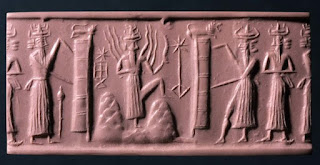Here's an interesting cylinder seal impression, about which I only know that it is from the first half of the first millennium BC and that it is currently in Louvre. I presume that it is from Mesopotamia...
The official description is "lion attacking bull"...That's it...That's it? Of course not...This is another complex animal calendar marker. This one telling people when to harvest dates...That's a date palm full of fruit on the right...
Late July and early August is date harvesting season in Iraq, when within the span of a few weeks the desert sun turns hard green spheres into tender, golden brown fruit prized for its sweetness...
Well....
Bull is the most common animal symbol for summer (May,Jun,Jul)...
This is because Apr/May, Taurus, the beginning of summer, is also the beginning of the calving of the wild Eurasian cattle. I talked about this in many posts...
Like "Green pastures" about this plaque from Tel Asmar...
Lion is also the most common animal symbol of autumn (Aug/Sep/Oct)...
This is because, Jul/Aug, Leo, the beginning of autumn, is also the beginning of the mating season of Eurasian lion. I talked about this in many posts...
Like "Canals", about the hottest and driest part of the year in Mesopotamia, Jul/Aug, Leo, when canals are repaired...See the sun god Shamash, standing in an empty canal, river bed, holding reed cutting knife, between two reed bundles topped by lions. Between lions means "in Leo"...
Like my post "Winged superhuman hero", about Nergal, the destructive sun of Jul/Aug, who was depicted as a lion, winged lion, lion dragon...

So the end of summer and the beginning of autumn can be symbolically depicted with a lion (autumn) killing (ending) bull (summer)...Which is what we see to the left of the palm tree...Oh, "coincidentally", that is exactly when you harvest dates in Mesopotamia...
Here is another cylinder seal impression, Elamite (Iran), ca. 11th–9th century BC. This one is from the met Museum, and its description is even better: "Cylinder seal with monster" Disappointed face Of course this is a lion, marking date harvest time.
I talked about this in my post 🙂 "Cylinder seal with monster"...
But what about the dog? Is that just a random detail? Have you ever wondered why was Sirius called "The Dog star"? And why were the hottest days of the year, at the end of summer, beginning of autumn (yup, middle of Leo, date harvest) called "Dog days"?
Because mating season of the oldest domesticated dog breeds, begins during dog days, end of Jul beginning of Aug...Right when you are supposed to get your butt up that date palm and start picking...
I talked about this in my post 🙂 "Dog days"
Sooooo...Complex calendar marker telling people when to pick dates. Eeeeeeee!!! What about the imp on the other side of the palm tree?!? I have no idea what that thing is...There has to be some mystery left in the world, right?
My question is: hasn't anyone before looked at this seal and wondered: why are all these thing depicted together? Is there any reason for that, any method behind the madness?
To read more about ancient animal and plant calendar markers, start here…then check the rest of the blog posts related to animal calendar markers I still didn't add to this page, and finally check my twitter threads I still didn't convert to blog post...I am 9 months behind now...











Have you ever wondered about the odd lacuna of Judah and Tamar in Genesis 38? Judah had as his symbol the Lion. And Tamar means date Palm. She was the wife of his son Er. Er was killed by God for being evil. The meaning of Er is given as awake. But I wonder if it is related to Ur or Auroch (the root given in Strongs is listed as Ur). He was supposed to be replaced by Onan who spilled his seed on the ground and was also killed. Onan means strength which is what the bull symbolized. The root of which is On which means strength and check out this usage of On, (strength)
ReplyDelete[Job 40:15-16 KJV] 15 Behold now behemoth, which I made with thee; he eateth grass as an ox. 16 Lo now, his strength [is] in his loins, and his force [is] in the navel of his belly.
I'd be interested in your thoughts on the rest of Gen 38, as it speaks of shearing sheep, 3 months later, a veiled harlot, all calendrical symbols.
Heliopolis was known as Iunu or On in the bible. Joseph married the daughter of the high priest of On, and Joseph's symbol was the bull through his son Ephraim and possibly Manasseh. On was the city of pillars which was the pylon, which symbolized the western mountains in which the sun sets, like the bulls horns that are the solar headdress of Hathor, meaning the House of Horus (the sun). His only full brother Benjamin which means son of my right hand (strength), was going to be named Ben - Oni by his mother, IMO Oni is relating to On, Heliopolis.